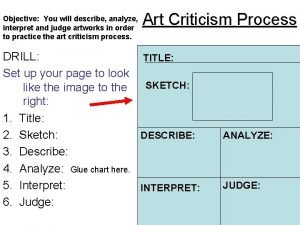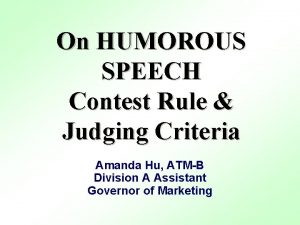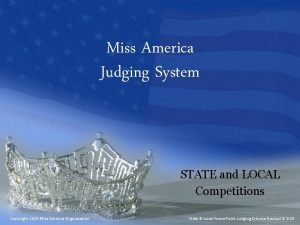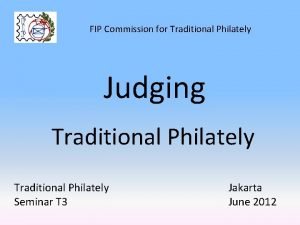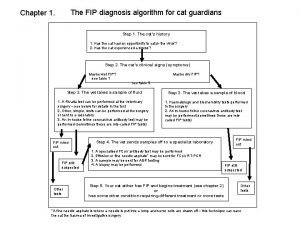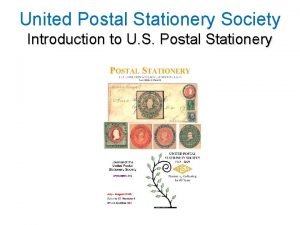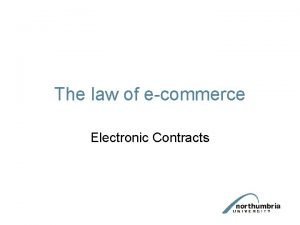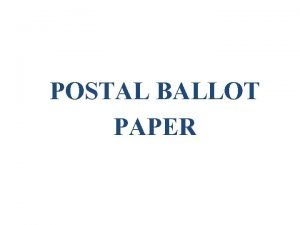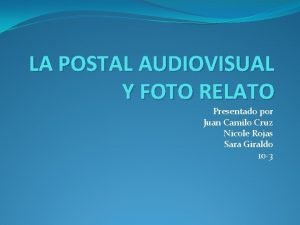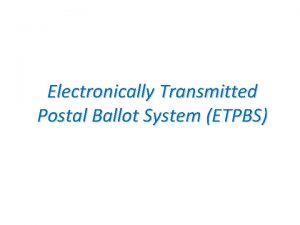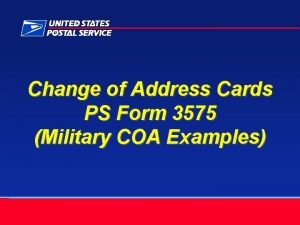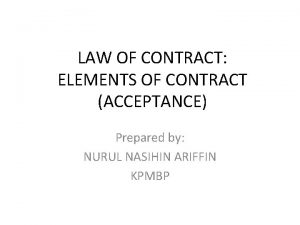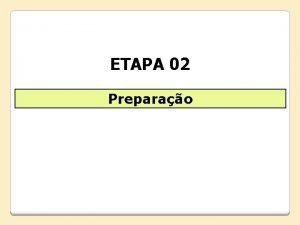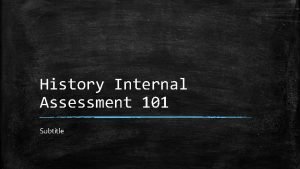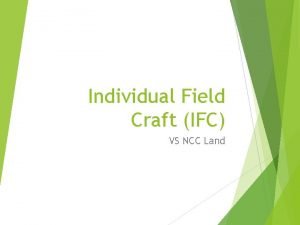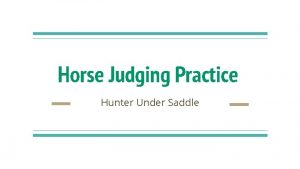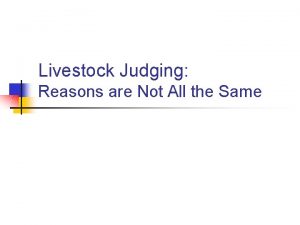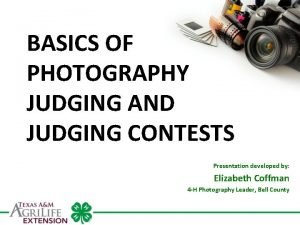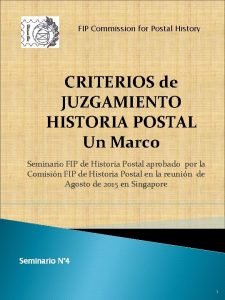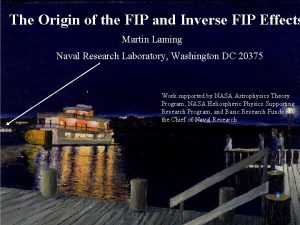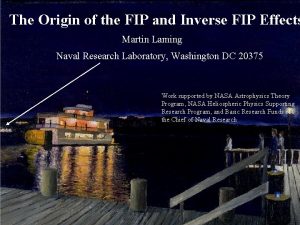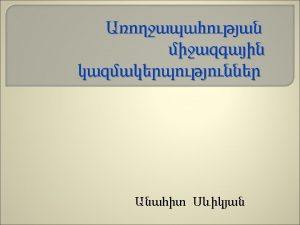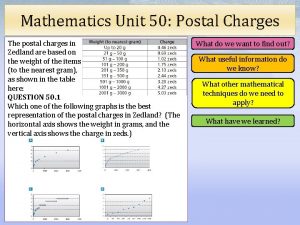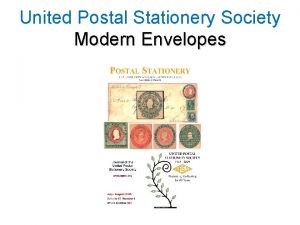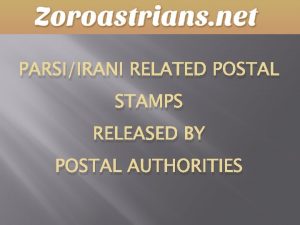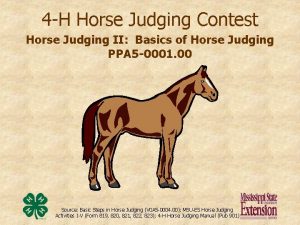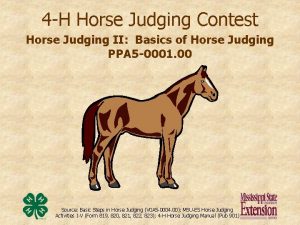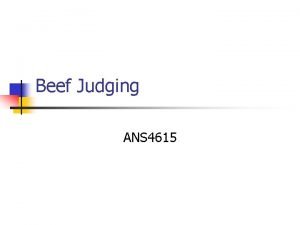FIP Commission for Postal History Judging Criteria for


























































- Slides: 58

FIP Commission for Postal History Judging Criteria for One-frame Postal History exhibit FIP Postal History Seminar approved by the FIP Postal History Commission at the meeting on August 17, 2015 in Singapore Streamline Seminar 4 1

The Judging Criteria for Postal History Exhibits Purpose of One-frame competition Provide collectors the opportunity to show exhibits with a narrow theme which are suitable for a one frame exhibit due to (i) the limited subject or (ii) the scarcity of the material to develop theme in one frame One-frame exhibits are also helpful in encouraging new exhibitors at the local and national level 2

The Judging Criteria for Postal History Exhibits Considerations v A Postal History One-frame exhibit can be harder to properly develop versus a One-frame exhibit in the Traditional class since many postal history subjects could be expanded to more than one frame v An extract out of an existing multi-frame exhibit is not allowed, however, it could be acceptable if the extracted material has been properly developed into a Oneframe exhibit 3

The Judging Criteria for Postal History Exhibits A Good One-frame exhibit should……. v Be restricted to a narrow scope subject appropriate to show as one frame (16 pages) v Present an interesting subject v Show good philatelic knowledge and evidence of personal study and/or research v Ideally, have at least one significant item on every page v Present a neat exhibit with a good balance of material and text within a page and within the frame 4

The Judging Criteria for Postal History Exhibits One-frame Postal History Awards v Currently in FIP World Stamp Exhibitions, participations in the One-frame class are awarded by the number of points achieved, a Oneframe Certificate and a participating medal which will be handed out to all the exhibitors 5

The Judging Criteria for Postal History Exhibits O-F Postal History Scoring system Total 100 Treatment and appropriate subject 30 Knowledge Personal Study Research 35 Condition Rarity 30 Presentation 5 6

The Judging Criteria for Postal History Exhibits Introduction v Judging the appearance of the exhibit: Presentation – 5 points v Judging the material included: Condition and Rarity 30 points v Judging what the exhibitor knows about the material presented: Knowledge and Personal Study 35 points v Judging if there is a balanced treatment and if the subject is appropriate for a one frame exhibit: Treatment 30 points 7

The Judging Criteria for Postal History Exhibits I. The Appearance of the Exhibit 8

The Judging Criteria for Postal History Exhibits PRESENTATION – 5 points v The appearance of the exhibit should complement the treatment of the exhibit by its general lay-out and clarity v Judges should evaluate the work put into the appearance of the exhibit from the point of view of how it facilitates the accessibility and attraction of the exhibit to judges and viewers alike 9

The Judging Criteria for Postal History Exhibits Accessibility: v Is there a clear connection between the philatelic material and the text? v Appropriate font size and style of text so the exhibit is easy to read? v Accessibility – use of tables and short paragraphs facilitates to understand the exhibit v Related non-philatelic material helps to make the exhibit more attractive and accessible 1 0

The Judging Criteria for Postal History Exhibits Attraction v The balance on each page v The balance in the frame v No wasted space especially in a Oneframe exhibit – § Empty space (except where used for rarity emphasis) § Space filled with unnecessary text or illustrations, large maps, or other “space filler” techniques. v The mounting is carefully and neatly done and not sloppy 1 1

The Judging Criteria for Postal History Exhibits Example of a poorly balanced page Too much blank space shown here! 1 2

The Judging Criteria for Postal History Exhibits Example of a well balanced page 1 3

The Judging Criteria for Postal History Exhibits Example of a poorly balanced page These two pages can be combined into one! 1 4

The Judging Criteria for Postal History Exhibits Example of a well balanced page 1 5

The Judging Criteria for Postal History Exhibits Example of a not-so-well balanced frame Too many one-cover page and apparently not enough material for a One-frame exhibit 1 6

The Judging Criteria for Postal History Exhibits Example of a better balanced frame Better frame balance, each one-cover page contains a significant item 1 7

The Judging Criteria for Postal History Exhibits II. The Material Presented in the Exhibit 1 8

The Judging Criteria for Postal History Exhibits Condition & Rarity 30 Points v When assessing rarity keep in mind it is both an objective and a relative term v. A judge needs to assess the difference between the rarity of an invitation envelope with a 1 d. Post Office Mauritius stamp versus a cancellation with an inverted year figure, even if only three of each have been so far recorded 1 9

The Judging Criteria for Postal History Exhibits Assessing Rarity It is impossible for a judge to know all the worldwide rare rates, routes and markings The judge needs to assess if the exhibitor has done the necessary personal study to determine how many of a particular rarity have been recorded 2 0

The Judging Criteria for Postal History Exhibits Assessing Rarity v Assess if the exhibit explains an item is rare § Just the word “unique” without an explanation is not acceptable. § Explanations to viewers must include exactly what is rare about the item �i. e. only recorded cover taking this route or with this rate or marking 2 1

The Judging Criteria for Postal History Exhibits Example of a poorly-explained rarity Just the phrase “Unique” is inadequate: Is it the only 1 Pi/10 kr Levant postcard on this shipping line? Or is the only item bearing the ship postmark? This is a lettercard and not a cover! 2 2

The Judging Criteria for Postal History Exhibits Example of a better-explained rarity Note the improvement in description: Short information explaining why the cancel is struck on card This is the only lettercard with footnote mentioning another cover The “rarity” concerns the cancel related to the shipping line Additional information about the Trieste-Shanghai Line given 2 3

The Judging Criteria for Postal History Exhibits Example of a well-explained rarity Reason is explained in the story-line at top. Rarity claim based on a published survey 2 quoted at the baseline 4

The Judging Criteria for Postal History Exhibits Number of Rare Items v Under rarity the judge should consider what the exhibit contains. § An exhibit with only ordinary material cannot get high rarity points § An exhibit with many rare items should get maximum points a few rarities are missing. v Missing items will be evaluated under treatment v If an exhibit has many rare items and is getting 29 -30 points for rarity and condition, adding more rare items may generate more points in Treatment if they improve the development 2 5

The Judging Criteria for Postal History Exhibits Condition & Rarity v While rarity is still in our minds, the judge should realize that an item in remarkable condition may be truly exceptional even though a large number of examples exist. v On the other hand, rare material in poor condition will not score as high if this material does exist in better condition. 2 6

The Judging Criteria for Postal History Exhibits Condition v When assessing condition the shown items should be in the best possible condition considering what is available to secure full points v Exceptions: § Disaster Mail § Disinfected Mail § Letters written to soldiers, etc; Judges should consider the circumstances and not expect this type of item to be in perfect condition 2 7

The Judging Criteria for Postal History Exhibits Assessing Condition Items in bad shape …. . § Ripped § Dirty § Missing parts of the envelope or letter § Stamps franking the covers badly cut into will get full points for condition even if many of the items are rare but are known to exist in better condition. 2 8

The Judging Criteria for Postal History Exhibits Example of a poor condition cover Subject is about treatment of damaged mail. Only 3 examples recorded of the marking 2 9

The Judging Criteria for Postal History Exhibits Example of a poor condition cover Although a rarity, this cover may lose marks on condition as there are similar covers in better condition. 3 0

The Judging Criteria for Postal History Exhibits Assessing Condition Markings v Assess readability: § Hand-written (manuscript) markings § Handstamps § Machine cancels v Full points for condition cannot be given if these strikes are not readable but are known to exist in better condition. v – Marcophily 3 1

The Judging Criteria for Postal History Exhibits III. What the Exhibitor Knows about the Material Displayed 3 2

The Judging Criteria for Postal History Exhibits Knowledge and Personal Study 35 points v Implicit Knowledge § Material selected is appropriate v Explicit Knowledge § Explanations and analysis in write-ups § Organization and balance of sections v Research & Personal Study § Stating researched and new Information in such a way that the viewers can learn something 3 3

The Judging Criteria for Postal History Exhibits Implicit Knowledge v Assess the material included or excluded from the exhibit this will indicate a strong or weak grasp of the chosen topic § Determine if the exhibit is just an accumulation of mostly rare covers without any connection to each other this could make the development of the chosen subject choppy and show a lack of philatelic knowledge § The judge would assess high rarity points but low knowledge and treatment points 3 4

The Judging Criteria for Postal History Exhibits Implicit Knowledge • Determine if the exhibit consists of mostly common covers showing common rates, routes or markings; such exhibits will not score well in treatment, knowledge or in rarity • If difficult to find rates, routes or markings are missing and common material has been duplicated such exhibits will not score well in treatment, knowledge or in rarity 3 5

The Judging Criteria for Postal History Exhibits Explicit Knowledge: Write-ups v Determine if the items shown are properly and accurately described v The judge should determine if all relevant markings and rates are noted with emphasis on the aspect for which the item is included § If the write-up only states the origin and destination of the cover, the total amount of the franking without explaining the rate, the visible postmarks and nothing else it will not score well for knowledge points 3 6

The Judging Criteria for Postal History Exhibits Explicit Knowledge: Write-ups § Assess if the write-up filters the important and relevant facts of each item shown and avoids lengthy write-ups of secondary and tertiary information or what obviously can be seen 3 7

The Judging Criteria for Postal History Exhibits Explicit Knowledge: Organization and Balance v Assess how well the organization reflects the primary focus of the exhibit v Assess if the sections are sized according to the subject matter § Sections that have too much or not enough material to properly explain the subject should lose points § Redundant rare items should lose points for knowledge 3 8

The Judging Criteria for Postal History Exhibits 3 9

The Judging Criteria for Postal History Exhibits Example of good philatelic knowledge 4 0

The Judging Criteria for Postal History Exhibits Personal Study & Research Assess the level of personal study and research contained in the exhibit v If the subject is relatively an untrodden aspect of postal history the judge would expect to find a good deal of personal study and the exhibit should be given credit for this or lose points if not present v If the subject is well-trodden assess the amount of personal study by the exhibitor’s grasp of the literature in their chosen subject and the analysis of this research v Also if the exhibit of a well trodden subject provides an appropriate fresh approach this deserves points for knowledge and personal study § Such an exhibit showing new research and results should be rewarded especially 4 1

The Judging Criteria for Postal History Exhibits Altered Material v Covers with § enhanced or altered postal marks § stamps added § Repairs which are not well noted in the exhibit show a and the exhibit has to lose points. Doubtful items should be assessed by the expert team. 4 2

The Judging Criteria for Postal History Exhibits Example of a rare cover with a repaired stamp 4 3

The Judging Criteria for Postal History Exhibits IV. Treatment Appropriate Subject 4 4

The Judging Criteria for Postal History Exhibits Appropriate subject v Is this a proper One-frame exhibit based on the set definition? v Focus - Assess which postal history aspect (rates, routes, markings or usage) is theme of the exhibit v Scope – Assess how clearly and logically the exhibit’s scope is defined v Subject Development – assess if this matches the set scope 4 5

The Judging Criteria for Postal History Exhibits Appropriate subject v. Judges will consider whether the exhibit subject is an appropriate Oneframe subject v. At the FIP level, up to 10 points from the treatment score could be deducted if the judges consider that the exhibit subject is not an appropriate one frame subject 4 6

The Judging Criteria for Postal History Exhibits Treatment: Focus v Focus - Postal History aspects** assessed by the judges: rates, routes, markings and usage. § Judges should assess how well the exhibit develops one of these aspects as the in the story § The judges also need to make sure the secondary aspects are discussed when it is appropriate § Judges should deduct points if the focus flip-flops from one aspect to another. ** Sub. Class 2 C – the unifying factor can be social or historical 4 7

The Judging Criteria for Postal History Exhibits Treatment - Focus v Assess if the exhibit focus, organization and balance is truly postal history and not just the “usage” section of an exhibit that would better fit in the Traditional Class § For example: Usage of the KG VI Issues of GB 4 8

The Judging Criteria for Postal History Exhibits Treatment : Scope v Any of the following can set the scope of the exhibit (or a combination of more than one) § Judges should assess how well the exhibit sets the of the exhibit if this is significant § The of the exhibit needs to be well defined if this is significant § The has to be set, government postal system, private enterprise postal system or military postal system if this is significant § scopes such as a railway or waterway or seaports for transatlantic mail or specific postal conventions if this is significant 4 9

The Judging Criteria for Postal History Exhibits Philatelic Importance has been replaced by “appropriate subject”. (FIP Congress in Lisbon 2010) v Subject significance – overall development within own field v Subject significance – world postal system development 5 0

The Judging Criteria for Postal History Exhibits Treatment : Subject Development v Section Balance § Logically based on the exhibit subject § Size appropriate to the exhibit subject v Sequence § Clearly defined if not chronological § No unexplained gaps v Material selected § Adequate to explain the subject § Few or no redundant examples (padding) § Here is where points should be deducted if important items are not present 5 1

The Judging Criteria for Postal History Exhibits Example of Introduction Page FP of OF (marcophily) exhibit, but title is not so clear; the map may not be needed; space wasted by describing what’s on each page instead of rarity; no reference quoted 5 2

The Judging Criteria for Postal History Exhibits Example of Introduction Page FP of OF PH exhibit. Only a brief plan is shown; the intro-page has an important cover instead of a map; extensive reference 5 3

The Judging Criteria for Postal History Exhibits Example of a poorly balanced page The geography and map of China not needed. Also one type of c. d. s. shown instead of both types mentioned in the text 5 4

The Judging Criteria for Postal History Exhibits Example of a well balanced page Better page using a parcel label (rather than a ppc or cover) bearing the second c. d. s. ; source of the postmark illustration 5 5 to demonstrate research

The Judging Criteria for Postal History Exhibits Example of unrelated non-philatelic material The focus is about censor mark of the camp, therefore a copy of the reverse side of the postcard is space-filling! Nothing is mentioned regarding the 5 CENSURADO mark in the description 6

The Judging Criteria for Postal History Exhibits Example of related non-philatelic material The photograph showing an ad-hoc attempt in aero-navigation is related to 5 the story 7

The Judging Criteria for Postal History Exhibits Thank You 5 8
 Usps regulatory commission
Usps regulatory commission Drawing competition judging criteria
Drawing competition judging criteria Analysis of the persistence of memory
Analysis of the persistence of memory Thank you note to preceptor after orientation
Thank you note to preceptor after orientation Declamation judgement criteria
Declamation judgement criteria Miss america judging criteria
Miss america judging criteria Devise a game scoring rubrics
Devise a game scoring rubrics Fip bs
Fip bs Fip
Fip Compilazione referto basket
Compilazione referto basket Ks eksamen
Ks eksamen Fip philately
Fip philately Fip diagnosis flowchart
Fip diagnosis flowchart Etalaze reviews
Etalaze reviews Aims and objectives of mudaliar commission
Aims and objectives of mudaliar commission Sections 1-6 1-7 commission and graduated commission
Sections 1-6 1-7 commission and graduated commission United postal stationery society
United postal stationery society Postal rule
Postal rule Henthorn v fraser
Henthorn v fraser Tarsila do amaral postcard
Tarsila do amaral postcard Postal industry trends
Postal industry trends Postal ballot paper format
Postal ballot paper format Postal audiovisual
Postal audiovisual Eco postal staff college
Eco postal staff college Postal address recognition
Postal address recognition Postal technology centre
Postal technology centre Electronically transmitted postal ballot system
Electronically transmitted postal ballot system Usps form 3575
Usps form 3575 Postal questionnaire
Postal questionnaire Postal sade
Postal sade Weatherby v banham
Weatherby v banham Meu código postal
Meu código postal Catequesis familiar
Catequesis familiar When is the history ia due
When is the history ia due Judging sheep
Judging sheep Judging sheep
Judging sheep Horse judging 101
Horse judging 101 Milk grading system
Milk grading system Livestock judging 101
Livestock judging 101 Individual field craft
Individual field craft Cookie judging rubric
Cookie judging rubric Hunter under saddle judging
Hunter under saddle judging Poultry judging practice
Poultry judging practice Fll robot design ideas
Fll robot design ideas Fll robot design judging
Fll robot design judging Ncrs judging sheets
Ncrs judging sheets Market steer judging
Market steer judging Closure-oriented/judging vs. open/perceiving
Closure-oriented/judging vs. open/perceiving Livestock judging transition terms
Livestock judging transition terms Scsa judging standards extranet
Scsa judging standards extranet 4-h photography judging
4-h photography judging Livestock judging powerpoints
Livestock judging powerpoints Horse conformation judging practice
Horse conformation judging practice 4-h photography judging
4-h photography judging Tmaa judging list
Tmaa judging list Livestock judging basics
Livestock judging basics Judging abstract photography
Judging abstract photography Poultry judging reasons
Poultry judging reasons Perceiving vs judging
Perceiving vs judging


